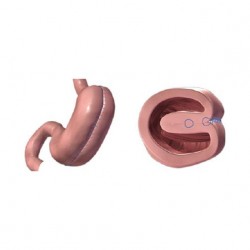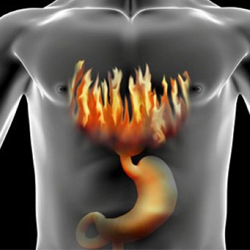
Gastric Plication in Guatemala
The laparoscopic gastric plication (also called vertical gastric placation, gastric folding or gastric greater curvature plication) is a new weight-loss surgery that has had promising results. It consists in vertically folding the stomach into itself. Once folded, it is sutured. It gives the stomach a shape similar to a sleeve gastrectomy without cutting the stomach. Consequently it is safer. Since there is no need for staplers to cut and divide the stomach, it is cheaper than the gastric bypass or the sleeve gastrectomy. Also, the anesthesia time is shorter, allowing patients to reincorporate faster, avoiding pulmonary complications.
It is a procedure that induces weight loss by decreasing the amount of food you can eat at a time. In the gastric plication surgery, approximately 80% of the total stomach capacity is reduced, therefore minimizing the capacity of the stomach to store food. In other words, it is another restrictive bariatric operation.
In the gastric placation surgery, approximately 80% of the total stomach is reduced, therefore minimizing the capacity of the stomach to store food.
The gastric plication is currently recommended if you eat large portions of food or if you need to lose a large amount of weight. The operation can be completed through laparoscopic or open surgery.
The gastric plication works similarly to the sleeve gastrectomy. You eat small amounts of food, you feel full, you stop eating, and you lose weight without feeling hungry. While the stomach is reduced in size, the stomach outlet and the nerves to the stomach remain intact; therefore its function is preserved. You will have a normal digestion of nutrients and you will not need nutritional supplements afterwards. Unlike the gastric bypass and the sleeve gastrectomy, the gastric plication is completely reversible.
While the stomach is reduced in size, the stomach outlet and the nerves to the stomach remain intact; therefore its function is preserved. You will have a normal digestion of nutrients and you will not need nutritional supplements afterwards.
The gastric plication operative technique
The gastric plication can be performed through laparoscopic surgery. All patients are given blood thinners and IV antibiotics before surgery. Additionally, you will have compressive stockings and an intermittent compressive device in your legs until you are completely recovered.
The technique for the gastric plication involves 5 small incisions through which a camera and small instruments are introduced into the abdomen. The surgery takes about one hour and a half and it requires general anesthesia.
A tube is passed from the esophagus into the duodenum (the first portion of the small bowel) and it is used to calibrate the diameter of the stomach that will be left in place. The portion of the stomach that enlarges when you eat food is folded in itself. Therefore, a thin portion of the stomach in the form of a cylinder is left in place. We use sutures to fix the stomach in place in order to prevent it from becoming unwrapped. The small bowel is not divided.
Unlike the gastric bypass and the sleeve gastrectomy, in the gastric plication there are no connections between the stomach and the intestine. Therefore, there is a much smaller risk of having a postoperative leak. Also, because of the shorter anesthesia time compared to the other bariatric operations, patients undergoing gastric plication have fewer postoperative pulmonary complications.
Unlike the gastric bypass and the sleeve gastrectomy, in the gastric plication there are no connections between the stomach and the intestine. Therefore, there is a much smaller risk of having a postoperative leak.
This operation can also be done through open conventional surgery in order to decrease costs. Open surgery might also be indicated in patients with multiple abdominal operations. Also, it can be done in patients with a successful gastric banding but have developed complications or have regained weight.
Recovery from gastric plication surgery
Regardless of the technique used to complete the gastric plication, you will be able to get out of bed the night of the operation. Since there are no cuts or connections in the stomach, you will be able to be started on a liquid diet the same day of your operation. All medications and liquids will be given in a liquid form. You will be discharged from the hospital the following day on the diet recommended by the dietitian. You will be back to your routine daily activities on an average of 5 to 7 days following surgery.
Diet after gastric plication surgery
After the gastric plication surgery you will have a strict follow-up with the dietitian. Once you restart your clear liquid diet the night of your operation. The next day you will be started on a full liquid diet including protein supplements to enhance your wound healing. You will have this diet for at least one week. You will then be advanced to pureed-type diet for the following two weeks. Depending on your progress, solid food will be reintroduced about three weeks following surgery. Nutritional supplements are not required following gastric plication surgery.
Our experience
Dr. Rodrigo Gonzalez is one of the very few surgeons practicing in Latin America who completed a supervised fellowship program at a University-affiliated hospital in the United States. He is also one of the few surgeons in Latin America performing gastric plication operations. His training involved the evaluation and preparation of clinically significant obese patients for weight-loss surgery. During his training, Dr. Rodrigo Gonzalez acquired sufficient experience and knowledge to be able to manage and treat patients with morbid obesity and to perform these operations here in the United States and any other country in the world.
Dr. Rodrigo Gonzalez is one of very few surgeons in Latin America who performs gastric plication operations.
Since his return to Guatemala, Dr. Rodrigo Gonzalez has dedicated most of his practice to bariatric surgery and has done well over hundreds of bariatric operations including gastric plication, Roux-en-Y gastric bypass, gastric banding, sleeve vertical gastrectomy, and revision of complicated or failed weight-loss operations to Roux-en-Y gastric bypass.
Dr. Rodrigo Gonzalez dedicated a significant amount of his time to study and research the field of Bariatrics. He has published over 25 papers in the most prestigious medical international journals and has been asked to write chapters for 5 books published in the United States and Great Britain. He has also been invited to publish review articles in renowned medical journals. He is considered by the international medical community as an expert in bariatric surgery and is therefore frequently asked to give talks in bariatric courses and meetings in order to present his experience in weight-loss surgery.




